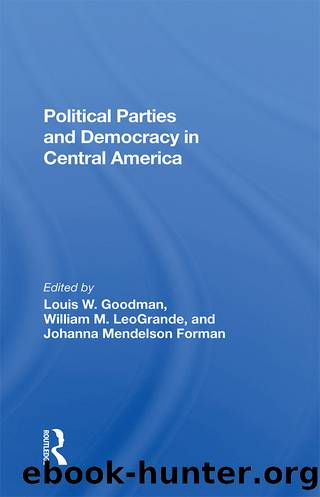Political Parties and Democracy in Central America by unknow

Author:unknow
Language: eng
Format: epub
Tags: Political Science, General
ISBN: 9781000307252
Google: 6h-eDwAAQBAJ
Goodreads: 46263039
Publisher: Routledge
Published: 2019-06-04T00:00:00+00:00
From Esquipulas to the 1990 Elections
For the Sandinistas, peace became imperative. In August 1987, Daniel Ortega, along with the other four Central American presidents, signed the Central American (Esquipulas II) peace accord. Each government pledged itself to democratic pluralism, free elections, and a concerted effort to end internal fighting by seeking a cease-fire with its armed opponents and initiating a process of political reconciliation. Each country promised to refrain from providing support or refuge for armed insurgents in the region, and together they called on other governments to do the same.
To comply with the agreement, the Sandinistas created the National Reconciliation Commission, which included an opposition party leader, a neutral Protestant clergyman, and, as chair, Cardinal Miguel Obando y Bravo, their harshest critic. Over the next few weeks, the government allowed the Catholic radio station to resume broadcasts and La Prensa to resume publishing, allowed exiled members of the Catholic church hierarchy to return to the country, and lifted restrictions on the internal opposition's right to hold demonstrations.
When the Central American presidents met in Costa Rica on January 15, 1988, to review progress on the Esquipulas accord, Daniel Ortega stole the headlines by finally agreeing to open direct talks with the Contras. He also announced that the Sandinistas would lift the state of emergency limiting the civic opposition's political liberties, hold free elections, and give up political power if they lost.24
In March the Sandinistas and Contras meeting in the small Nicaraguan town of Sapoa signed a cease-fire agreement. The agreement embodied most of the Contras demands. The Sandinistas agreed to a general amnesty for both the Contras and the remaining members of Somoza's National Guard still imprisoned for war crimes. Exiles would be allowed to return to the country without fear of prosecution and could participate fully in national political life. The Contras would be allowed to send delegates to the "national dialogue" between the Sandinistas and the civic opposition over how to carry out the Esquipulas agreement. Although sporadic fighting continued throughout the next two years, full-scale combat operations did not resume.
Once the Sandinistas relaxed legal constraints on free expression, as mandated by the Esquipulas agreement, the civic opposition roared to life. A new, broad coalition of opposition parties, the Group of Fourteen, was formed in 1987, and included most of the parties from the Democratic Coordinating Committee that boycotted the 1984 election and the parties (even some of the leftist ones) that participated in that election. With the Nicaraguan economy disintegrating, the civic opposition saw a tremendous opportunity to rally public opinion to its side. The Sandinistas saw that possibility, too. Fearful that Washington's financial support would transform the opposition into a formidable foe, the Sandinistas sought to constrain its activities. But the guarantees of democracy in the Esquipulas accord limited what the government could do. Its main strategy was harassment and intimidation. In January 1988, for example, shortly after the state of emergency was lifted, the Sandinista police arrested twelve opposition leaders to question them about their ties to the Contras.
Download
This site does not store any files on its server. We only index and link to content provided by other sites. Please contact the content providers to delete copyright contents if any and email us, we'll remove relevant links or contents immediately.
Zero to IPO: Over $1 Trillion of Actionable Advice from the World's Most Successful Entrepreneurs by Frederic Kerrest(4298)
Machine Learning at Scale with H2O by Gregory Keys | David Whiting(4186)
Never by Ken Follett(3795)
Harry Potter and the Goblet Of Fire by J.K. Rowling(3775)
Ogilvy on Advertising by David Ogilvy(3512)
Shadow of Night by Deborah Harkness(3305)
The Man Who Died Twice by Richard Osman(2997)
Book of Life by Deborah Harkness(2868)
The Tipping Point by Malcolm Gladwell(2828)
Will by Will Smith(2794)
0041152001443424520 .pdf by Unknown(2784)
My Brilliant Friend by Elena Ferrante(2775)
How Proust Can Change Your Life by Alain De Botton(2743)
Purple Hibiscus by Chimamanda Ngozi Adichie(2652)
How to Pay Zero Taxes, 2018 by Jeff A. Schnepper(2602)
Hooked: A Dark, Contemporary Romance (Never After Series) by Emily McIntire(2502)
Rationality by Steven Pinker(2291)
Borders by unknow(2231)
Can't Hurt Me: Master Your Mind and Defy the Odds - Clean Edition by David Goggins(2228)
